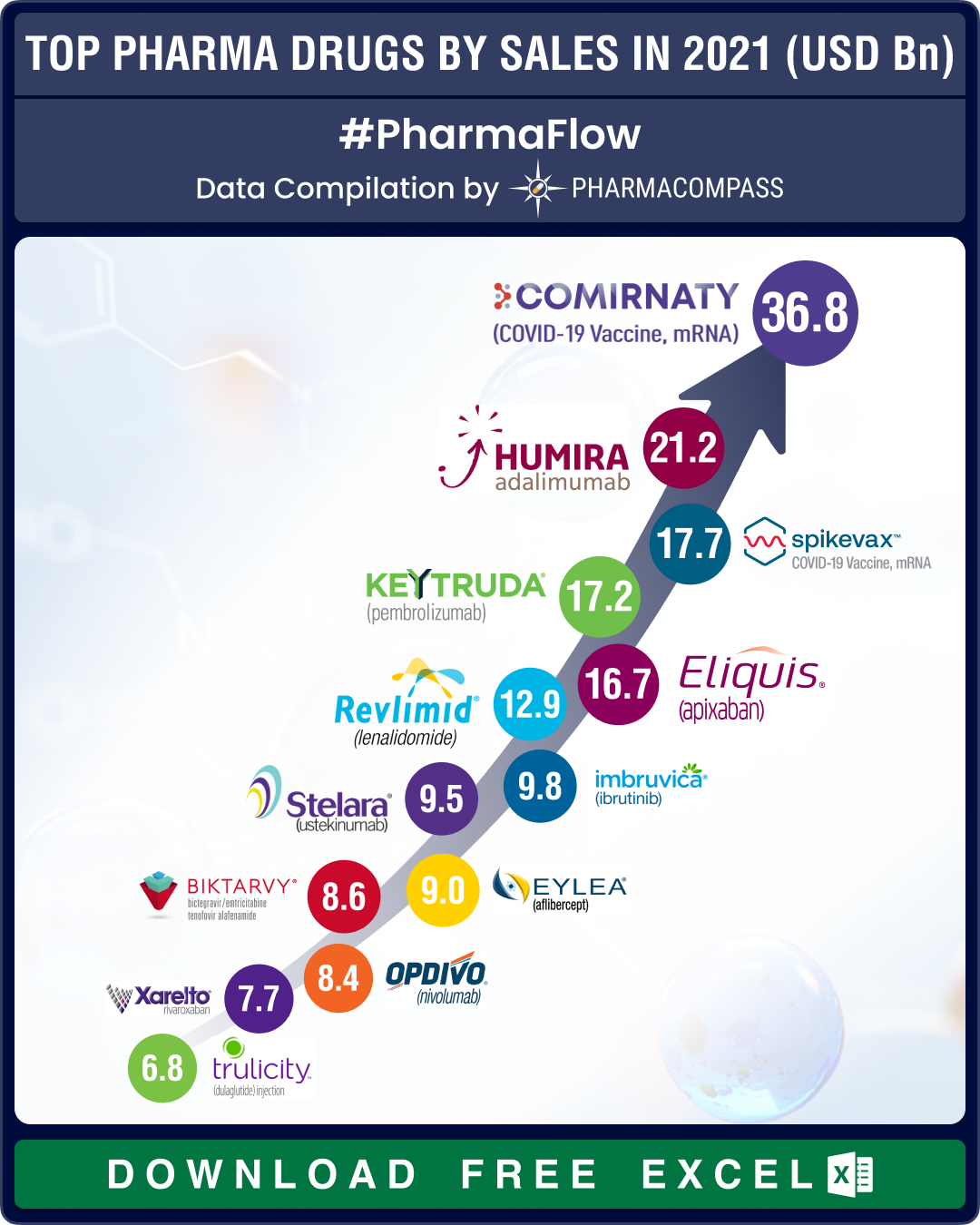
By PharmaCompass
2022-04-28
Impressions: 8461
Every year, the list of top pharmaceutical products and companies by sales sees some churn. But the year 2021 was a lot different — it saw the pharma industry landscape change dramatically. It was a year when the industry was busy developing vaccines and therapies so that the world could recover from the Covid-19 pandemic. And this resulted in many drugmakers raking in billions of dollars in sales.
As a result, the top company of 2020 in terms of pharmaceutical sales — Roche — slipped to the number five spot, while Pfizer, which was at number eight in 2020 after spinning off its generic business, moved up to the number one slot.
The year proved to be a good one for pharmaceutical companies. Interestingly, last year none of the top 20 pharmaceutical companies saw a decline in their revenue.
View Our Interactive Dashboard on Top Drugs by Sales in 2021 (Free Excel Available)
Pfizer’s Comirnaty steals the show
The company that reaped the maximum gains from its Covid vaccine was Pfizer. Comirnaty (tozinameran) was the top selling pharmaceutical product of 2021, posting global revenues of US$ 36.8 billion. This messenger-RNA Covid-19 vaccine, developed along with its German partner BioNTech, catapulted Pfizer to the slot of the top company by sales in 2021. Pfizer’s global topline grew from US$ 41.7 billion in 2020 to US$ 81.3 billion in 2021.
In 2020, Pfizer was at number eight, behind Roche, Novartis, GSK, AbbVie, J&J, Merck and BMS. In 2021, it took a lead of billions of dollars on all these companies. The second largest drug company by sales — AbbVie — was way down at US$ 56.1 billion in global revenues. In fact, Comirnaty has become the fastest-selling drug in the history of the pharmaceutical industry.
Back in December 2020, when both Comirnaty and Moderna’s Spikevax had bagged the US Food and Drug Administration’s emergency use authorization (EUA), there was a lot of uncertainty around how the promised doses would be delivered across the world. But both Comirnaty and Spikevax have proven to be a resounding success. Spikevax emerged as the third largest selling pharmaceutical product of 2021, bringing in US$ 17.7 billion for Moderna.
Analysts expect both Pfizer-BioNTech and Moderna to sell even more vaccines in 2022. The reasons are manifold. First, SARS-CoV-2 is able to mutate often, and is unlikely to be eradicated in the near future, creating a need for booster shots. Second, the younger age groups are still to get vaccinated.
Along with Comirnaty, Pfizer is battling Covid-19 with its antiviral pill, Paxlovid. Though the sales of Paxlovid have nosedived of late, Pfizer expects Comirnaty and Paxlovid to help the New York-headquartered drug behemoth achieve US$ 100 billion in 2022 revenues.
View Our Interactive Dashboard on Top Drugs by Sales in 2021 (Free Excel Available)
AbbVie moves up, sans Covid product; Roche slips to number five
With no Covid-19 related products, AbbVie did fairly well in 2021 — it moved up from the number four spot in 2020 to number two position, thanks to its Allergan acquisition, cash cow Humira (adalimumab), the continued success of its cancer drug Imbruvica (ibrutinib) and an increase in sale of its psoriasis treatment Skyrizi (risankizumab) by a whopping 85 percent in 2021. Humira brought in sales of US$ 21.2 billion for AbbVie in 2021. However, things may change soon, with biosimilars of Humira slated to enter the market in 2023. The years 2022 and 2023 are likely to be transition years for AbbVie, as it works to build the market for its Humira successors — Rinvoq and Skyrizi.
Roche emerged as a big loser in 2021, as several copycats of its blockbuster drugs hit the market. Copycats to Roche’s three blockbuster cancer drugs—Avastin, Herceptin and Rituxan—eroded US$ 4.9 billion (CHF 4.73 billion) from the company’s sales in 2021. A large chunk of growth for Roche came from its multiple sclerosis med Ocrevus, hemophilia drug Hemlibra, inflammatory disease therapy Actemra and PD-L1 inhibitor Tecentriq. The pandemic resulted in lower-than-expected sales of Ocrevus (ocrelizumab) due to fears around its immunosuppressive effects.
Like Roche, Novartis also slipped last year. It fell from number two in 2020 to the number four slot in 2021. Essentially, Novartis is struggling with a relatively lackluster pipeline. It had sold its 33 percent stake in Roche last year for US$ 20.7 billion. It plans to use that sum for acquisitions in order to beef up its pipeline. The Swiss drugmaker has also drawn up a restructuring plan that includes layoffs of thousands of employees.
Before the pandemic, Merck’s Keytruda was touted as the drug that would overtake Humira at the top in 2024. The checkpoint inhibitor has continued to grow impressively, adding new indications and treatment lines. Keytruda is now used in close to 40 indications. With US$ 17.2 billion in sales, Keytruda emerged as the fourth largest selling drug of 2022.
Overall though, Merck slipped from number six to the number eight slot. This was due to the fact that Merck had spun out its women’s health, biosimilars and established brands businesses into Organon. However, its Covid-19 antiviral pill — Molnupiravir — was able to compensate for the lost revenue. Though the FDA is yet to grant the drug a full approval (it bagged an EUA in December 2021), advance sales agreements helped it rack up US$ 952 million in sales in the fourth quarter.
View Our Interactive Dashboard on Top Drugs by Sales in 2021 (Free Excel Available)
BMS moves up with Eliquis, Revlimid; J&J lands at number three
Bristol Myers Squibb (BMS) moved up from number seven in 2020 to number six, thanks to two of its drugs that made it to top 10 — anticoagulant Eliquis at number five and oncology drug Revlimid at number six. However, Revlimid will soon face competition — four generic companies now have the approval to sell their versions of Revlimid (lenalidomide) after March 2022. Revlimid sales are expected to drop from US$ 12.9 billion to just US$ 2.06 billion in 2026.
BMS posted US$ 46.4 billion in global revenues, a nine percent increase from US$ 42.5 billion reported in 2020. In immuno-oncology, Opdivo brought in US$ 7.52 billion in sales, while Yervoy drew in sales of US$ 2 billion (an increase of 20 percent).
J&J’s pharma division brought in US$ 52.1 billion in revenues last year, an increase of 14 percent over its revenues of US$ 45.6 billion posted in 2020. Drugs like Darzalex (for multiple myeloma), Stelara and its Covid-19 vaccine brought in growth during 2021, helping J&J move up from number five to the number three slot. J&J’s Covid-19 vaccine brought in US$ 2.4 billion in sales.
View Our Interactive Dashboard on Top Drugs by Sales in 2021 (Free Excel Available)
GSK bags approval for shingles vaccine; Takeda suffers setbacks
GlaxoSmithKline (GSK) slipped four places — from number three in 2020 to number seven in 2021. Though GSK did not have a drug in the top 10, sales of GSK and Vir Biotechnology’s Covid-19 antibody treatment sotrovimab helped produce a seven percent increase in its 2021 revenue. The British drugmaker also bagged a critical FDA approval — its vaccine to prevent shingles (herpes zoster), Shingrix, bagged the agency’s nod in July. GSK hopes to double the sales of Shingrix by 2026.
GSK is also undergoing a major transformation, and plans to demerge its consumer health unit this year. The unit generated revenues of £9.6 billion (US$ 13 billion) last year, and GSK sees the demerger as a necessary step to fuel growth through the development of new vaccines and specialty medicines.
Sanofi managed to retain its ninth slot, even as its global turnover increased from US$ 39.3 billion (Euro 36.04 billion) to US$ 41.6 billion (Euro 37.76 billion). It snapped up Kymab, Tidal Therapeutics, Translate Bio, Kadmon Holdings, Origimm Biotechnology and Amunix in deals that bolstered its presence in immunology, immuno-oncology and vaccines. Dealmaking is on the French drugmaker’s menu for 2022 and beyond, Sanofi’s CFO said at this year’s virtual JP Morgan Healthcare Conference.
AstraZeneca’s global revenues grew from US$ 26.6 billion in 2020 to US$ 37.4 billion in 2021. However, its rank fell from nine in 2020 to 10 in 2021.
AstraZeneca wrapped up the US$ 39 billion acquisition of Alexion in July 2021. Alexion’s rare disease franchise—led by C5 inhibitors Soliris and Ultomiris—added an extra US$ 3.1 billion to Astra’s top line last year.
Takeda suffered several clinical and regulatory setbacks in 2021, which it labeled as an “inflection year.” For Gilead, sales of its Covid-19 antiviral Veklury brought in US$ 5.6 billion last year, helping its revenues grow by 11 percent.
View Our Interactive Dashboard on Top Drugs by Sales in 2021 (Free Excel Available)
Our view
If anything, the pandemic has taught us that change is the only constant. It has also taught us that products can become blockbusters in a matter of a few months.
The industry landscape continues to change. On the one hand, we are seeing people scrambling to get Covid vaccines and booster shots, on the other hand, the FDA has limited the use of monoclonal antibodies, such as Eli Lilly’s bamlanivimab and etesevimab and Regeneron’s REGEN-COV (casirivimab and imdevimab), in treating Covid caused by the Omicron variant. The FDA has also pulled the authorization granted to GSK and Vir Biotechnology’s antibody therapy this month, citing data that suggested it was unlikely to be effective against the dominant Omicron sub-variant.
And last week, there was news that demand for Pfizer’s antiviral pill Paxlovid has remained unexpectedly low. The supply of Paxlovid, which reduced hospitalizations or deaths in high-risk patients by around 90 percent in a clinical trial, has far outstripped demand in many countries like the US, the UK and South Korea.
Though Pfizer is hopeful of crossing US$ 100 billion in revenue this year, much depends on how the pandemic pans out and what new research has to say about the novel coronavirus. A lot will change once the pandemic becomes endemic. The first four months of 2022 tell us that vaccines like Comirnaty and Spikevax will continue to perform well. But two years down the line, our charts could look very different.
The PharmaCompass Newsletter – Sign Up, Stay Ahead
Feedback, help us to improve. Click here
Image Credit : Top Pharma Companies & Drugs in 2021 by PharmaCompass is licensed under CC BY 2.0
“ The article is based on the information available in public and which the author believes to be true. The author is not disseminating any information, which the author believes or knows, is confidential or in conflict with the privacy of any person. The views expressed or information supplied through this article is mere opinion and observation of the author. The author does not intend to defame, insult or, cause loss or damage to anyone, in any manner, through this article.”







